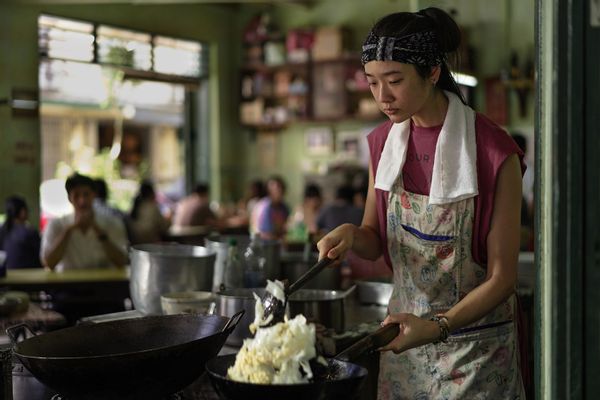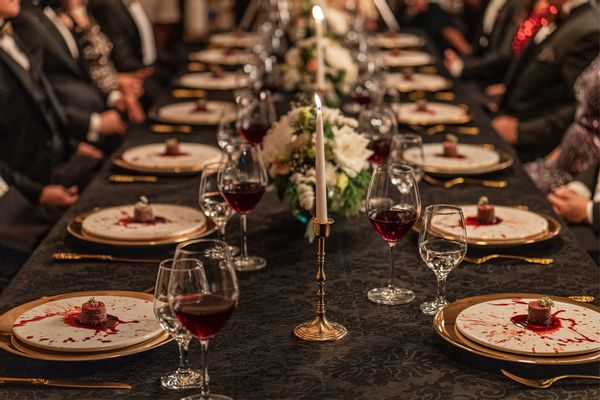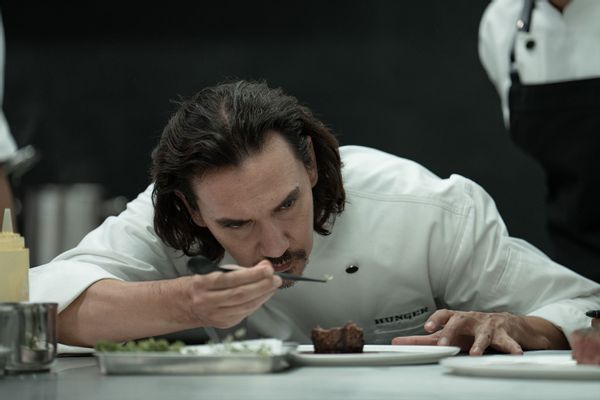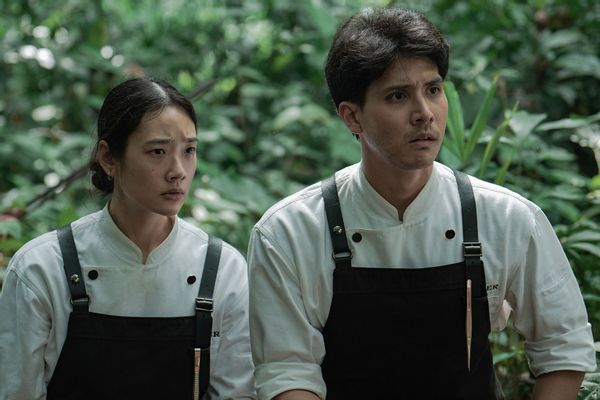
Netflix viewers' appetite for culinary thriller "Hunger" has been going strong.
The Thai-language film has been in Netflix's global Top 10 for non-English films for the past four weeks since its release. And while themes of class explored through the world of food and fine dining have become a trend in recent media like "The Menu," "Triangle of Sadness" and "The Bear," this film both fits in and stands out.
"I want people to watch and to think, 'Am I supposed to feel good? Am I supposed to feel bad while watching it?'"
In the film, Aoy (Chutimon Chuengcharoensukying) is a master with fire and her wok, working at her family's street food stall and stir-frying up bowls of pad see ew and other Thai dishes. When she's given the opportunity, Aoy joins Hunger, a catering service for the wealthy run by the famous Chef Paul (Nopachai Chaiyanam). In his intense, cutthroat kitchen, Aoy learns to cook expensive, elaborate meals with more emphasis on technique, shock value and price tag than she's used to.

Throughout the film, Aoy finds herself grappling with the pressure of fine dining and cooking expensive meals for the rich. But "Hunger" director Sitisiri Mongkolsiri doesn't see the food as the main focus of the film.
"After developing it for a while, we found that actually this movie isn't really about food, but it's about the word hunger. And that's how we started to develop from there. People, when they're hungry, it's not just hunger for food," Mongkolsiri said. "This is a bit about psychology as well — what do humans really hunger for? And that's how we developed the script."
While the food is presented through gorgeous stills and close-ups – familiar to "Chef's Table" presentations – Mongkolsiri also utilizes aerial shots that create movement.
But "Hunger" also inverts the appetizing way we're used to food being presented onscreen. In one scene in particular, a group of wealthy guests at a politician's birthday dine on meat slathered in a thick, red sauce that drips outside and around their mouths as they eat. It's unsettling, uncomfortable and a little bit gross, which is exactly what Mongkolsiri wanted.
"Actually, my intention was that I wanted to make this movie about food, but food that is a bit gross to watch," Mongkolsiri said, laughing.
Check out the rest of the interview with Mongkolsiri, who communicated through an interpreter.
The following has been lightly edited for length and clarity.
What drew you to this project?
I worked with another person, Kongdej [Jaturanrasamee], to write the screenplay together. The initial idea was that we wanted to do a project about food, that was the rough idea, because Thailand is known for its food. When I look at the street, you see people cooking and eating all the time, and this goes on around the clock.
There's been a recent trend of poking fun at high culture restaurants in media. Do you see any specific similarities or differences between "Hunger" and "The Menu"? Why do you think films that focus on fine dining and class are becoming more prevalent now?
Fine dining in Thailand has only been really known in less than 10 years. And I feel like fine dining around the world is kind of a wave right now — it's a modern-day topic that people talk about. And the trend of everybody who eats out, they take photos of their food. When I was young, I mean, nobody did that.

I loved your episodes of "Girl From Nowhere," do you see a connection between the two?
The person who wrote the screenplay is Kongdej, who is the same person I used for this project. I got to know Kongdej for six to seven years now, just hanging out and talking about projects.
I feel like Thailand, in the past 10 years, we've gone through a lot. And there's a lot of problems with class division In Thailand right now, and it's really not fair. The people who are more wealthy or rich, they have more access to things versus the people who are underprivileged. I feel like the gap is getting wider and wider. I feel that the underprivileged people don't really have a voice. And I think that's the thing that connects many projects together, whether you're doing a movie, or you're a musician, or any field, I think we're trying to convey the voices of those groups of people.
Some of the scenes of the wealthy people eating were uncomfortable or gross to watch. Did you direct the actors to eat in a certain way?
I want people to watch and to think, "Am I supposed to feel good? Am I supposed to feel bad while watching it?" And have that kind of unsure feeling in your stomach while watching. The way I treated the scenes or the way I portrayed the food — that was the intention. I think about whether you're someone rich or someone underprivileged, when you're hungry, you just have one thought. You just want to satisfy your hunger, you just want to put the food in your mouth as quickly as possible. And sometimes you just have no manners.
Chef Paul was so scary. What direction did you give Nopachai to play him like that?
The character of Chef Paul, he's not that real. I actually wanted the character to be quite an exaggeration, because he represents the dark side of Aoy. So, he's not that realistic actually. He's more of a fantasy type of character, which I see as God sending down to test Aoy.

This is something that really happens in Thailand. People with power, they actually do this and it's in the news. It's just going through the law right now, going through the process. I think my approach to this is that this scene is not really talking about food, but rather is talking about power. These people in power just want to show their power. Because the hornbill is not delicious, it's just a bird. They're just doing it to show that I can do it, I have the power to do it.
What was the intention when it came to comparing the two worlds that Aoy cooks in: her family run wok-fired Thai traditional dishes versus the fine dining?
If you watch to the end of the movie, it was showing you that wok-fried food or street food, if you develop it well, is quite comparable to fine dining. Thailand is known for street food, and you see it on the street everywhere. The thing is, it hasn't been developed in order for it to actually have value or be expensive. So that's really my point of view, I feel that you can develop a street food to have value by really going back to your roots.
What were the challenges of shooting all the cooking scenes with fire?
The challenge really falls with the character Aoy or Aokbab [Chutimon Chuengcharoensukying]. She had so many burns on her arms. I feel that, working in food, there's a lot of challenges and difficulties, especially because you want it to come out realistic. And my intention is not to use CG. I wanted the characters to really feel the real heat at that moment. Hence it was extremely challenging for the characters, but everything ended up well and it went well.

"In one place you might have something very luxurious and a street next to it, you'll see poverty."
I do feel there's a lot of change. For example, we all know the world famous Jay Fai, who's the most famous street food chef. And also in fine dining as well, you're seeing fine dining being made from Thai food and fine dining made from traditional Thai ingredients mixed with some modern ingredients. It's all based on our Thai roots. I think this is a new wave from the new generation chefs — they're taking all the knowledge, their training that they received, and now they're mixing it with their local ingredients.
There are scenes that show poverty and people living in the streets. What was your intention with those scenes? How much realism was involved?
I think the scenes are scenes that I see on the streets, that I can see nowadays. And especially the location of Aoy's restaurant, the local one, it's called Old Town and you can see the scene the way it is [portrayed]. I think that the importance is not really whether it's realism or not, but rather that the movie is trying to make a statement by comparing the people who have and the have-nots.
I think this kind of portrays Thailand. If you come to Thailand, you will see — everything is next to one another. In one place you might have something very luxurious and a street next to it, you'll see poverty. They're just mixed together in the same area. And that is why I want the people who watch the movie to feel a little bit uneasy.
"Hunger" is streaming on Netflix.







